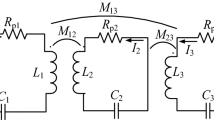Abstract
In this paper we establish the general and specific frequency splitting principles in wireless power transfer and inductive near field communication systems. Frequency splitting of inductive frequency response functions is normally a result of degraded performance of wireless power transfer systems. This degradation is due to operating the system at distances shorter than the critical coupling distance. Causes and effects of frequency splitting are studied, modelled and simulated using Matlab in this paper. Hardware evaluation of split frequency phenomenon is evaluated to confirm that coupling coefficients higher than critical coupling coefficient leads to frequency splitting. The split frequencies are used to advantage as sources of multiple frequency transmissions in single-input-multiple output systems thereby leading to improved power and data transfer. An application of frequency splitting in data transfer shows improved system capacity of up to 20% when compared with straightforward resonance approach.


















Similar content being viewed by others
References
Sun, Z., & Akyildiz, I. F. (2009). Underground wireless communications using magnetic induction. In Proceedings of IEEE ICC 2009 (pp. 1–5).
Sojdehei, J. J., Wrathall, P. N., & Dinn, D. F. (2001). Magneto-inductive (MI) communications. In Proceedings of MTS/IEEE conference and exhibition (OCEANS 2001) (pp. 513–519).
Kopparthi, S. (2003). Remote power delivery and signal amplification for MEMS applications. MSc Thesis, Andhra University, India, Dec 2003.
Noguchi, S., Inamori, M., Sanada, Y. (2011). Data transmission for resonant-type wireless power transfer. In 14th International symposium on wireless personal multimedia communications (WPMC’11) (pp. 1–5).
Inanlou, F., & Ghovanloo, M. (2011). Wideband near-field data transmission using pulse harmonic modulation. IEEE Transactions on Circuits and Systems-I: Regular Papers, 58(1), 186–195.
Dionigi, M., & Mongiardo, M. (2012). A novel resonator for simultaneous wireless power tranfer and near field magnetic communications. In IEEE MTT-S, Microwave symposium digest.
Dionigi, M., & Mongiardo, M. (2012). Multi band resonators for wireless power tranfer and near field magnetic communications. In Proceedings of IMWS-IWPT (pp. 61–64).
Agbinya, J. I. (2017). Recursive frequency allocation scheme in wireless power transfer and inductive communication systems. Wireless Personal Communications. https://link.springer.com/search?sortOrder=newestFirst&facet-content-type=Article&facet-journal-id=11277.
Thanh, H. D., & Agbinya, J. I. (2012). Effects of second neighbour interaction on frequency splitting in near field inductive communication systems. In Proceedings of IB2COM 2012, November 5–6, Sydney, Australia (pp. 190–195).
Sample, A. P., Meyer, D. A., & Smith, J. R. (2011). Analysis, experimental results, and range adaption of magnetically coupled resonators for wireless power transfer. IEEE Transaction on Industrial Electronics, 58(2), 544–554.
Cannon, B. L., Hoburg, J. F., Stancil, D. D., & Goldstein, S. C. (2009). Magnetic resonant coupling as a potential means for wireless power transfer to multiple receivers. IEEE Transactions on Power Electronics, 24(7), 1819–1825.
Kim, J. W., Son, H.-C., Kim, K.-H., & Park, Y.-J. (2011). Efficiency analysis of magnetic resonance wireless power transfer with intermediate resonant coil. IEEE Antennas and Wireless Propagation Letters, 10, 389–392.
Imura, T., Okabe, H., & Hori, Y. (2009). Basic experimental study on helical antennas of wireless power transfer for electric vehicles by using magnetic resonant couplings. In Proceedings of IEEE vehicle power and propulsion conference, 2009, VPPC’09 (pp. 936–940).
Scher, A. (2010). Tutorial: positive coupling, negative coupling, and all that. http://aaronscher.com/Circuit_a_Day/Impedance_matching/positive_negative_coupling/positive_negative_coupling.html.
Ahn, D., & Hong, S. (2013). A study on magnetic field repeaters in wireless power transfer. IEEE Transactions on Industrial Electronics, 60(1), 360–371.
Nguyen, H., & Agbinya, J. I. (2015). Splitting frequency diversity in wireless power transmission. IEEE Transactions on Power Electronics, 30(11), 6088–6096.
Thanh, H. D., & Agbinya, J. I. (2016). OFDM scheme for data transmission over inductive channels. Wireless Personal Communications, 88(4), 923–942.
Nguyen, H., Agbinya, J. I., & Devlin, J. (2015). FPGA-based implementation of multiple modes in near field inductive communication using frequency splitting and MIMO configuration. IEEE Transactions on Circuits and Systems I: Regular Papers, 62, 302–310.
Mohamed, N. F. A., Agbinya, J. I., & Aboura, K. (2016). Frequency allocation strategy in inductive wide area wireless energy transfer systems. In The 2nd international conference on communication, information technology and robotics, 2–4 June 2016, Dubai, United Arab Emirates.
Mohamed, N. F. A., Agbinya, J. I., & Aboura, K. (2016). Multi-spectral, multidimensional wireless power transfer systems. In Symposium on research spotlight in modelling and simulation of physical and biological systems, depending on space, time, retardation, anticipation, at the 36th anniversary meeting of the international institute for advanced studies (IIAS) & 28th international conference on systems research, informatics and cybernetics (Baden-Baden, Germany, from August 1st to August 5th, 2016).
Agbinya, J. I., & Masihpour, M. (2012). Power equations and capacity performance of magnetic induction communication systems. Wireless Personal Communications Journal, 64(4), 831–845.
Waffenschmidt, E. (2011). Wireless power for mobile devices. In Proceedings IEEE 33rd International Telecommunications Energy Conference (INTELEC), Amsterdam, Netherlands, 9–13 Oct 2011 (pp. 1–9)
Author information
Authors and Affiliations
Corresponding author
Additional information
Publisher's Note
Springer Nature remains neutral with regard to jurisdictional claims in published maps and institutional affiliations.
Rights and permissions
About this article
Cite this article
Agbinya, J.I., Nguyen, H. Principles and Applications of Frequency Splitting in Inductive Communications and Wireless Power Transfer Systems. Wireless Pers Commun 107, 987–1017 (2019). https://doi.org/10.1007/s11277-019-06313-1
Published:
Issue Date:
DOI: https://doi.org/10.1007/s11277-019-06313-1




